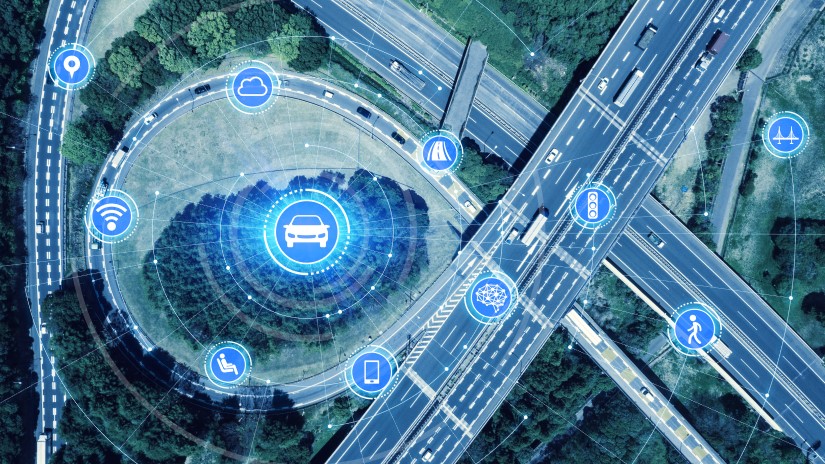By Harsha Badarinarayan, Vice President, R&D at Hitachi America, Ltd.
For years, getting a driver’s license was a coming-of-age ritual, and owning your own car was a symbol of independence. But times have changed. Driver’s license applications by 16-year-olds continue to trend significantly downward.i And consumers are increasingly replacing the concept of my vehicle with the concept of a vehicle comes to me when I want it.
A plethora of options is making multimodality in transportation a daily reality for many. For example, a shopper might pick up an e-scooter waiting on a street corner to drive to a shopping destination, drop it off at the entrance, and then hop on a bus to return home. This new ecosystem of multimodal transportation is helping people easily get from point A to point B, especially in urban, high-density areas ― unencumbered by the responsibility of vehicle ownership or operation.
In addition to new business models, transportation technology itself is rapidly evolving. A wide range of innovations are being integrated into existing transportation options to make urban mobility more smarter and sustainable. The goal is to improve everything from predictive maintenance to automated braking to passenger comfort by connecting vehicles to advanced technologies through the cloud.
One such emerging transportation innovation that could be a game changer for multimodal transportation is the connected autonomous vehicle (AV). The successful integration of multiple supporting technologies will be essential to the success of autonomous vehicles as they are incorporated into various transportation systems. More importantly, just like with prior transportation innovations, the defining factor for the success of these technologies will be public trust.

Reliable data is the backbone of any smart, connected ecosystem ― whether that system is a connected car, a mass transit vehicle or an entire network of diverse modes of public transportation. This data includes not only the data about the vehicle itself and how it interacts with its surroundings, but also data about its passengers. Yet in study after study, when it comes to connected cars and AVs, consumers report significant concerns over data privacy and security.ii
Another major concern for consumers is safety. Connected vehicles hold great promise for reducing the number of traffic accidents related to human error. But we’re not yet at the point where people feel assured that riding in an AV is safer than having control over that vehicle themselves, or with another human at the helm. This is a crucial hurdle to overcome. However with increasingly sophisticated safety features in self-driving cars, such as the advanced driver assistance systems for complex driving environments, AVs will prove to be a big step toward a sustainable transportation future for all.
One way to address privacy concerns is through “privacy by design” ― embedding data privacy and security directly in the ecosystem design phase rather than incorporating them as afterthoughts. Components in this approach include:
When it comes to safety, one puzzle to be solved is localization — knowing exactly where a vehicle is relative to its surroundings. Another is accurate trajectory planning; for example, how a vehicle will make a turn at an upcoming signal or intersection. Solving these two challenges will shed light on how the vehicle will maneuver in a complex, dense urban environment. From there, key technologies such as high-definition maps and remote vehicle control systems that leverage 5G can be developed to refine the interaction between the vehicle and the infrastructure.
Technology companies can add to these efforts by focusing on “explainable artificial intelligence (AI),” which can boost public trust in connected systems by helping people understand:

With decades of experience and core technologies in the automotive industry, Hitachi is deeply engaged in the development of smart mobility technologies that are driving the multimodal explosion. For example, Hitachi has developed or co-developed in-vehicle weather intelligence, environmentally friendly engine management systems, and stereo cameras for improved automatic emergency braking at intersections. Directly addressing the issue of public trust, Hitachi has developed both a next-generation smart navigation solution to enhance localization and a high-precision trajectory tracking technology to improve the safety of AVs on public roads.
Many organizations have joined the effort to mass-deploy connected technologies, including AVs, and win consumer confidence. But it’s not yet a fully coordinated effort. There is opportunity for governments and governmental agencies to join in with legislation that regulates data privacy, security and safety to put everyone on the same page and help consumers develop trust in this technology.
At Hitachi, we’ll continue to champion these types of joint efforts while developing the innovative technology that can make multimodal or futuristic transportation mainstream. By leveraging groundbreaking innovation, together we can evolve a reliable, safe and dependable system ― one that the public understands and trusts. When we do, the future of smart mobility will be wide open.
Learn more about how Hitachi is powering good in multimodal transportation.

Vice President, R&D at Hitachi America, Ltd.
Harsha Badarinarayan is the Vice President of R&D at Hitachi America, Ltd. He has been with Hitachi for over 17 years. In his current role, Harsha is involved in strategic planning for automotive business expansion in the U.S., specifically related to the Connected Cars and Autonomous Mobility. His work focuses on developing automated driving technology and identifying potential go-to-market (GTM) solutions for automotive-related use cases. Harsha holds 14 U.S. patents and has authored or co-authored over 30 technical publications.